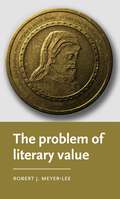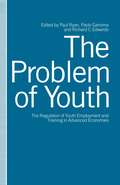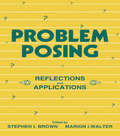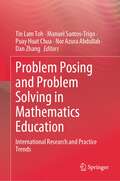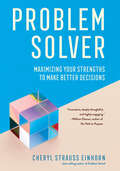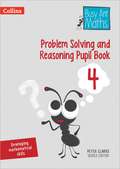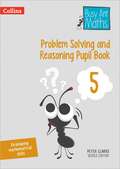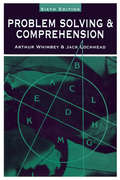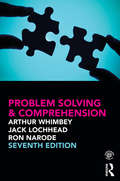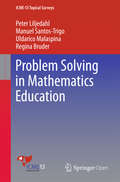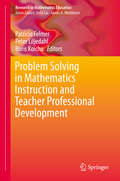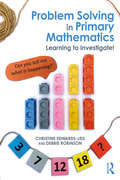- Table View
- List View
The problem of literary value (Manchester Medieval Literature and Culture)
by Robert J. Meyer-LeeThis book addresses the vexed status of literary value. Unlike other approaches, it pursues neither an apologetic thesis about literature’s defining values nor, conversely, a demystifying account of those values’ ideological uses. Instead, arguing that the category of literary value is inescapable, it focuses pragmatically on everyday scholarly and pedagogical activities, proposing how we may reconcile that category’s inevitability with our understandable wariness of its uncertainties and complicities. Toward these ends, it offers a preliminary theory of literary valuing and explores the problem of literary value in respect to the literary edition, canonicity and interpretation. Much of this exploration occurs within Chaucer studies, which, because of Chaucer’s simultaneous canonicity and marginality, provides fertile ground for thinking through the problem’s challenges. Using this subfield as a synecdoche, the book seeks to forge a viable rationale for literary studies generally.
The problem of literary value (Manchester Medieval Literature and Culture)
by Robert J. Meyer-LeeThis book addresses the vexed status of literary value. Unlike other approaches, it pursues neither an apologetic thesis about literature’s defining values nor, conversely, a demystifying account of those values’ ideological uses. Instead, arguing that the category of literary value is inescapable, it focuses pragmatically on everyday scholarly and pedagogical activities, proposing how we may reconcile that category’s inevitability with our understandable wariness of its uncertainties and complicities. Toward these ends, it offers a preliminary theory of literary valuing and explores the problem of literary value in respect to the literary edition, canonicity and interpretation. Much of this exploration occurs within Chaucer studies, which, because of Chaucer’s simultaneous canonicity and marginality, provides fertile ground for thinking through the problem’s challenges. Using this subfield as a synecdoche, the book seeks to forge a viable rationale for literary studies generally.
The Problem of the Process of Transmission in the Pentateuch (The Library of Hebrew Bible/Old Testament Studies)
by Rolf RendtorffRolf Rendtorff is interested above all in the process by which the Pentateuch reached the form in which it now lies before us. He concludes that the classic Documentary Hypothesis has been tried in the fire and found wanting, and traces briefly the scholarly path that led him to this conclusion. His approach has been met with strong disagreement, cautious agreement, and, in some quarters, relief and readiness to look for other ways than that of the documentary hypothesis to explain the formation of the Pentateuch. It is certain, however, that scholars of the Pentateuch cannot ignore Rendtorff's important volume.
The Problem of Youth: The Regulation of Youth Employment and Training in Advanced Economies
by Richard Edwards Paolo Garonna Paul RyanThe book covers the vocational training and employment of young workers in various European and North American advanced economies; the forms taken by regulation of youth economic activity and the effects of its deregulation; training systems, training policies and access to skilled work in various paired-country comparisons; and the links between trade unions and young workers in two country-specific case-studies.
Problem Posing: Reflections and Applications
by Stephen I. Brown Marion I. WalterAs a result of the editors' collaborative teaching at Harvard in the late 1960s, they produced a ground-breaking work -- The Art Of Problem Posing -- which related problem posing strategies to the already popular activity of problem solving. It took the concept of problem posing and created strategies for engaging in that activity as a central theme in mathematics education. Based in part upon that work and also upon a number of articles by its authors, other members of the mathematics education community began to apply and expand upon their ideas. This collection of thirty readings is a testimony to the power of the ideas that originally appeared. In addition to reproducing relevant materials, the editors of this book of readings have included a considerable amount of interpretive text which places the articles in the context of problem solving. While the preponderance of essays focus upon mathematics and mathematics education, some of them point to the relevance of problem posing to other fields such as biology or psychology. In the interpretive text that accompanies each chapter, they indicate how ideas expressed for one audience may be revisited or transformed in order to ready them for a variety of audiences.
Problem Posing: Reflections and Applications
by Stephen I. Brown Marion I. WalterAs a result of the editors' collaborative teaching at Harvard in the late 1960s, they produced a ground-breaking work -- The Art Of Problem Posing -- which related problem posing strategies to the already popular activity of problem solving. It took the concept of problem posing and created strategies for engaging in that activity as a central theme in mathematics education. Based in part upon that work and also upon a number of articles by its authors, other members of the mathematics education community began to apply and expand upon their ideas. This collection of thirty readings is a testimony to the power of the ideas that originally appeared. In addition to reproducing relevant materials, the editors of this book of readings have included a considerable amount of interpretive text which places the articles in the context of problem solving. While the preponderance of essays focus upon mathematics and mathematics education, some of them point to the relevance of problem posing to other fields such as biology or psychology. In the interpretive text that accompanies each chapter, they indicate how ideas expressed for one audience may be revisited or transformed in order to ready them for a variety of audiences.
Problem Posing and Problem Solving in Mathematics Education: International Research and Practice Trends
by Tin Lam Toh Manuel Santos-Trigo Puay Huat Chua Nor Azura Abdullah Dan ZhangThis book presents both theoretical and empirical contributions from a global perspective on problem solving and posing (PS/PP) and their application, in relation to the teaching and learning of mathematics in schools. The chapters are derived from selected presentations in the PS/PP Topical Study Group in ICME14. Although mathematical problem posing is a much younger field of inquiry in mathematics education, this topic has grown rapidly. The mathematics curriculum frameworks in many parts of the world have incorporated problem posing as an instructional focus, building on problem solving as its foundation. The juxtaposition of problem solving and problem posing in mathematics presented in this book addresses the needs of the mathematics education research and practice communities at the present day. In particular, this book aims to address the three key points: to present an overview of research and development regarding students’ mathematical problem solving and posing; to discuss new trends and developments in research and practice on these topics; and to provide insight into the future trends of mathematical problem solving and posing.
Problem Postcards: Social, Emotional and Behavioural Skills Training for Disaffected and Difficult Children aged 7-11 (PDF)
by Brian Marris Janine Koeries Tina Rae`This is an excellent resource for teachers and other education professionals who are developing their practice in dealing with specific issues in schools. It is concise, well designed and, in the introductory section, linked to current theory. It will prove an invaluable resource for teachers and others who want to develop the social and emotional skills of their pupils' - Special `There is a wealth of supporting resources in the form of suggested warm up activities and the specifics are the problem solving format as applied to different situations. The accompanying CD contains A4 copies of all worksheets, which are accessible, eye-catching and should appeal to the target age group (7-11)' - Nurturing Potential This 14-session programme was initially developed for junior age children who had been permanently excluded. It has been adapted to assist young people who are disaffected and difficult, and could be at risk of exclusion. The format is built around Circle Time activities and solution focused thinking. The theme of each session is a problem postcard from a young person highlighting a problem that will have a relevance to the participants. The participants then try to act as agony aunts to solve the problem, focussing their thinking on how to make things better, proving to them that they do possess the knowledge and the skills and can choose these behaviours. The resource includes comprehensive facilitator instructions, warm ups, activities, Circle Time questions and worksheets. The programme can be delivered to groups or whole classes and will: • improve self-esteem • develop your Social, Emotional and Behavioural Skills (SEBS) programme.
Problem Solver: Maximizing Your Strengths to Make Better Decisions (AREA Method Publications)
by Cheryl Strauss EinhornOur decisions are expressions of who we are and how we move through the world. Rarely, though, do we examine our decisions or even look inward to consider the psychology of our decision-making. Instead, we often make decisions based on what we call instinct (which relies on cognitive bias), false assumptions, mis-remembering, and mental mistakes. Truthfully, we don't see the world as it is; we see it as we are. We can develop self-knowledge about our decision-making styles. We can wake ourselves up to how biases cloud our judgment and impede good decision-making—and we can counter bias. From there, we can transform our decision-making habits to make better big decisions alone and together. Problem Solver provides you with tools to identify:• The five basic decision-making approaches, or "Problem Solver Profiles" (PSPs): Adventurer, Detective, Listener, Thinker, and Visionary • Your dominant—and secondary—PSPs• Tools to assess other peoples' PSPs• Each PSP's decision-making strengths, blind spots, and biases• How your PSP impacts your outlook on life and your risk appetite• How to use your PSP to maximize your decision strengths Replete with real-life examples and replicable strategies to apply new decision-making skills for your immediate benefit, Problem Solver will do more than help you look out into a future; it will equip you to move forward, with confidence, into your future.
Problem Solving
by S. Ian RobertsonProblem solving is an integral part of everyday life yet few books are dedicated to this important aspect of human cognition. In each case, the problem, such as solving a crossword or writing an essay, has a goal. In this comprehensive and timely textbook, the author discusses the psychological processes underlying such goal-directed problem solving, and examines both how we learn from experience of problem solving and how our learning transfers (or often fails to transfer) from one situation to another. Following initial coverage of the methods we use to solve unfamiliar problems, the book goes on to examine the psychological processes involved in novice problem solving before progressing to the methods and processes used by skilled problem solvers or "experts". Topics covered include: how we generate a useful representation of a problem as a starting point; general problem solving strategies we use in unfamiliar situations; possible processes involved in insight or lateral thinking; the nature of problem similarity and the role of analogies in problem solving; understanding and learning from textbooks; and how we develop expertise through the learning of specific problem solving skills. Clear, up-to-date and accessible, Problem Solvingwill be of interest to undergraduates and postgraduates in cognitive psychology, cognitive science, and educational psychology. The focus on the practical transfer of learning through problem solving will also make it of relevance to educationalists and business psychologists. 9780203457955 9781134631018 9780415203005
Problem-solving 3-4
by Hyacinth Dorleon Karen Morrison Rodney JulienWe live in an increasingly technological and information-rich world. Education is focusingmore on enquiry and skills-based approaches. Students, even at the early levels ofschooling, are expected to develop a range of skills, including problem solving skills.Creative thinking, using information appropriately and problem solving are important for students in the school curriculum and in daily life. This book will help students learn how to apply mathematical skills in different contexts and explain how they got to their solutions.This book is easy for parents and teachers to use, and teaches multiple strategies forsolving problems, using challenging but supportive contexts. The approach is underpinnedby the Five E's approach to learning.The course will help student to:· Engage with problems meaningfully· Explore different options for approaching and solving problems· Explain how they are thinking· Elaborate on their working and processes and see connections between different areasof mathematics· Evaluate what worked and what didn't, learning from mistakes as well as successes
Problem-solving 5-6
by Hyacinth Dorleon Karen Morrison Rodney JulienWe live in an increasingly technological and information-rich world. Education is focusingmore on enquiry and skills-based approaches. Students, even at the early levels ofschooling, are expected to develop a range of skills, including problem solving skills.Creative thinking, using information appropriately and problem solving are important for students in the school curriculum and in daily life. This book will help students learn how to apply mathematical skills in different contexts and explain how they got to their solutions.This book is easy for parents and teachers to use, and teaches multiple strategies forsolving problems, using challenging but supportive contexts. The approach is underpinnedby the Five E's approach to learning.The course will help student to:· Engage with problems meaningfully· Explore different options for approaching and solving problems· Explain their thought processes · Elaborate on their working and processes and see connections between different areasof mathematics· Evaluate what worked and what didn't, learning from mistakes as well as successes
Problem Solving and Reasoning Pupil Book 4 (Busy Ant Maths)
by Peter ClarkePupils can quickly get to grips with KS2 problem solving and reasoning by completing activities categorised by topic and question type. Fully in line with the new National Curriculum. Problem solving and reasoning have been key focuses within primary maths since the introduction of the 2014 curriculum, and the focus on ‘teaching for mastery’. It is essential that all pupils have access to problem solving and reasoning activities.
Problem Solving and Reasoning Pupil Book 5 (Busy Ant Maths Ser.)
by Peter ClarkePupils can quickly get to grips with KS2 problem solving and reasoning by completing activities categorised by topic and question type. Fully in line with the new National Curriculum. Problem solving and reasoning have been key focuses within primary maths since the introduction of the 2014 curriculum, and the focus on ‘teaching for mastery’. It is essential that all pupils have access to problem solving and reasoning activities.
Problem-solving and Thinking Skills Resources for Able and Talented Children
by Barry Teare This treasure trove of resources is divided into ten themed sections, each preceded by an outline giving the key principles, links with curriculum guidelines and an explanation about the importance of the particular skill. Charts at the beginning of the book summarize curriculum links and skills involved. Each photocopiable activity is accompanied by teachers' notes, and fully explained solutions are given where appropriate.
Problem Solving & Comprehension: A Short Course in Analytical Reasoning
by Arthur Whimbey Jack Lochhead Ronald NarodeThis popular book shows students how to increase their power to analyze problems and to comprehend what they read. First, it outlines and illustrates the method that good problem solvers use in attacking complex ideas. Then, it provides practice in applying these methods to a variety of comprehension and reasoning questions. Books on the improvement of thinking processes have tended to be complicated and less than useful, but the authors of this renowned text emphasize a simple but effective approach. The "Whimbey Method" of teaching problem solving is now recognized as an invaluable means of teaching people to think. Problems are followed by their solutions, presented in easy-to-follow steps. This feature permits students to work without supervision, outside the classroom. As students work through the book they will see a steady improvement in their analytical thinking skills, and will develop confidence in their ability to solve problems--on tests; in academic courses; and in any occupations that involve analyzing, untangling, or comprehending knotty ideas. By helping students to become better problem solvers, this book can assist students in achieving higher scores on tests commonly used for college and job selection, such as: * Scholastic Aptitude Test (SAT) * Graduate Record Examination (GRE) * ACT Work Keys * Terra Nova * Law School Admission Test (LSAT) * Wonderlic Personnel Test * United States Employment Service General Aptitude Test Battery * Civil Service Examination New in the 6th edition: A totally new chapter--"Meeting Academic and Workplace Standards: How This Book Can Help"--describes changes in the educational system in the past 20 years and shows how the techniques taught in this book relate to the new educational standards and tests. Changes throughout the book reflect current educational and social realities: the names of some characters have been changed to represent more accurately the cross-section of students attending today's schools; dates in some problems have been changed; in other problems the technology referred to has been updated.
Problem Solving & Comprehension: A Short Course in Analytical Reasoning
by Arthur Whimbey Jack Lochhead Ronald NarodeThis popular book shows students how to increase their power to analyze problems and to comprehend what they read. First, it outlines and illustrates the method that good problem solvers use in attacking complex ideas. Then, it provides practice in applying these methods to a variety of comprehension and reasoning questions. Books on the improvement of thinking processes have tended to be complicated and less than useful, but the authors of this renowned text emphasize a simple but effective approach. The "Whimbey Method" of teaching problem solving is now recognized as an invaluable means of teaching people to think. Problems are followed by their solutions, presented in easy-to-follow steps. This feature permits students to work without supervision, outside the classroom. As students work through the book they will see a steady improvement in their analytical thinking skills, and will develop confidence in their ability to solve problems--on tests; in academic courses; and in any occupations that involve analyzing, untangling, or comprehending knotty ideas. By helping students to become better problem solvers, this book can assist students in achieving higher scores on tests commonly used for college and job selection, such as: * Scholastic Aptitude Test (SAT) * Graduate Record Examination (GRE) * ACT Work Keys * Terra Nova * Law School Admission Test (LSAT) * Wonderlic Personnel Test * United States Employment Service General Aptitude Test Battery * Civil Service Examination New in the 6th edition: A totally new chapter--"Meeting Academic and Workplace Standards: How This Book Can Help"--describes changes in the educational system in the past 20 years and shows how the techniques taught in this book relate to the new educational standards and tests. Changes throughout the book reflect current educational and social realities: the names of some characters have been changed to represent more accurately the cross-section of students attending today's schools; dates in some problems have been changed; in other problems the technology referred to has been updated.
Problem Solving & Comprehension
by Arthur Whimbey Jack Lochhead Ronald NarodeThis popular book shows students how to increase their power to analyze problems and comprehend what they read using the Think Aloud Pair Problem Solving [TAPPS] method. First it outlines and illustrates the method that good problem solvers use in attacking complex ideas. Then it provides practice in applying this method to a variety of comprehension and reasoning questions, presented in easy-to-follow steps. As students work through the book they will see a steady improvement in their analytical thinking skills and become smarter, more effective, and more confident problem solvers. Not only can using the TAPPS method assist students in achieving higher scores on tests commonly used for college and job selection, it teaches that problem solving can be fun and social, and that intelligence can be taught. Changes in the Seventh Edition: New chapter on "open-ended" problem solving that includes inductive and deductive reasoning; extended recommendations to teachers, parents, and tutors about how to use TAPPS instructionally; Companion Website with PowerPoint slides, reading lists with links, and additional problems.
Problem Solving & Comprehension
by Arthur Whimbey Jack Lochhead Ronald NarodeThis popular book shows students how to increase their power to analyze problems and comprehend what they read using the Think Aloud Pair Problem Solving [TAPPS] method. First it outlines and illustrates the method that good problem solvers use in attacking complex ideas. Then it provides practice in applying this method to a variety of comprehension and reasoning questions, presented in easy-to-follow steps. As students work through the book they will see a steady improvement in their analytical thinking skills and become smarter, more effective, and more confident problem solvers. Not only can using the TAPPS method assist students in achieving higher scores on tests commonly used for college and job selection, it teaches that problem solving can be fun and social, and that intelligence can be taught. Changes in the Seventh Edition: New chapter on "open-ended" problem solving that includes inductive and deductive reasoning; extended recommendations to teachers, parents, and tutors about how to use TAPPS instructionally; Companion Website with PowerPoint slides, reading lists with links, and additional problems.
Problem Solving for Teaching and Learning: A Festschrift for Emeritus Professor Mike Lawson
by Helen Askell-Williams Janice OrrellProblem Solving for Teaching and Learning explores the importance of problem solving to learning in everyday personal and social contexts. This book is divided into four sections: Setting the scene; Conceptualising problem solving; Teachers’ knowledge and beliefs about problem solving; and Fostering students’ problem-solving capabilities, allowing readers to gain an insight into the various sub-topics that problem solving in learning and teaching introduce. Drawing together diverse perspectives on problem solving located in a variety of educational settings, this book explores problem solving theory, including its cognitive architecture, as well as attending to its translation into teaching and learning in a range of settings, such as education and social environments. This book also suggests how effective problem-solving activities can be incorporated more explicitly in learning and teaching and examines the benefits of this approach. The ideas developed in Problem Solving for Teaching and Learning will act as a catalyst for transforming practices in teaching, learning, and social engagement in formal and informal educational settings, making this book an essential read for education academics and students specialising in cognitive psychology, educational psychology, and problem solving.
Problem Solving for Teaching and Learning: A Festschrift for Emeritus Professor Mike Lawson
by Helen Askell-Williams Janice OrrellProblem Solving for Teaching and Learning explores the importance of problem solving to learning in everyday personal and social contexts. This book is divided into four sections: Setting the scene; Conceptualising problem solving; Teachers’ knowledge and beliefs about problem solving; and Fostering students’ problem-solving capabilities, allowing readers to gain an insight into the various sub-topics that problem solving in learning and teaching introduce. Drawing together diverse perspectives on problem solving located in a variety of educational settings, this book explores problem solving theory, including its cognitive architecture, as well as attending to its translation into teaching and learning in a range of settings, such as education and social environments. This book also suggests how effective problem-solving activities can be incorporated more explicitly in learning and teaching and examines the benefits of this approach. The ideas developed in Problem Solving for Teaching and Learning will act as a catalyst for transforming practices in teaching, learning, and social engagement in formal and informal educational settings, making this book an essential read for education academics and students specialising in cognitive psychology, educational psychology, and problem solving.
Problem Solving in Mathematics Education (ICME-13 Topical Surveys)
by Peter Liljedahl Manuel Santos-Trigo Uldarico Malaspina Regina BruderThis survey book reviews four interrelated areas: (i) the relevance of heuristics in problem-solving approaches – why they are important and what research tells us about their use; (ii) the need to characterize and foster creative problem-solving approaches – what type of heuristics helps learners devise and practice creative solutions; (iii) the importance that learners formulate and pursue their own problems; and iv) the role played by the use of both multiple-purpose and ad hoc mathematical action types of technologies in problem-solving contexts – what ways of reasoning learners construct when they rely on the use of digital technologies, and how technology and technology approaches can be reconciled.
Problem Solving in Mathematics Instruction and Teacher Professional Development (Research in Mathematics Education)
by Peter Liljedahl Patricio Felmer Boris KoichuRecent research in problem solving has shifted its focus to actual classroom implementation and what is really going on during problem solving when it is used regularly in classroom. This book seeks to stay on top of that trend by approaching diverse aspects of current problem solving research, covering three broad themes. Firstly, it explores the role of teachers in problem-solving classrooms and their professional development, moving onto—secondly—the role of students when solving problems, with particular consideration of factors like group work, discussion, role of students in discussions and the effect of students’ engagement on their self-perception and their view of mathematics. Finally, the book considers the question of problem solving in mathematics instruction as it overlaps with problem design, problem-solving situations, and actual classroom implementation. The volume brings together diverse contributors from a variety of countries and with wide and varied experiences, combining the voices of leading and developing researchers. The book will be of interest to any reader keeping on the frontiers of research in problem solving, more specifically researchers and graduate students in mathematics education, researchers in problem solving, as well as teachers and practitioners.
Problem Solving in Primary Mathematics: Learning to Investigate!
by Christine Edwards-Leis Debbie RobinsonProblem Solving in Primary Mathematics is an essential text designed to support new and experienced teachers in guiding pupils through mathematical investigations and problem solving, offering a framework that children themselves can begin to adopt as they progress to greater metacognitive awareness. Underpinned by the latest international research and theory, it examines how individual pupils think and act differently and offers guidance on how to promote independence and autonomy in the classroom. It examines key topics such as: Preparing for mathematical learning Designing learning material Assessing and evaluating learning Identifying key points for intervention What to do when learning is stalled Critical numeracy for real-world problem solving Mental Model Theory and the Mental Model Mode Different approaches to problem solving and investigating Aimed at new and experienced educators, particularly those with a maths specialism, and illustrated with investigations and activities, Problem Solving in Primary Mathematics demonstrates how frameworks can be used in key mathematical areas and assists students in progressing towards more meaningful problem solving.
Problem Solving in Primary Mathematics: Learning to Investigate!
by Christine Edwards-Leis Debbie RobinsonProblem Solving in Primary Mathematics is an essential text designed to support new and experienced teachers in guiding pupils through mathematical investigations and problem solving, offering a framework that children themselves can begin to adopt as they progress to greater metacognitive awareness. Underpinned by the latest international research and theory, it examines how individual pupils think and act differently and offers guidance on how to promote independence and autonomy in the classroom. It examines key topics such as: Preparing for mathematical learning Designing learning material Assessing and evaluating learning Identifying key points for intervention What to do when learning is stalled Critical numeracy for real-world problem solving Mental Model Theory and the Mental Model Mode Different approaches to problem solving and investigating Aimed at new and experienced educators, particularly those with a maths specialism, and illustrated with investigations and activities, Problem Solving in Primary Mathematics demonstrates how frameworks can be used in key mathematical areas and assists students in progressing towards more meaningful problem solving.
